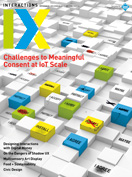Authors:
Damien Ablart, Carlos Velasco, Chi Vi, Elia Gatti, Marianna Obrist
Designing multisensory experiences has always fascinated artists and scientists alike. In recent years, there has been a growing interest in multisensory experience design within the HCI community [1]. Next to advances in haptic technologies, we see novel work on olfactory and gustatory systems [2,3] and efforts in determining multisensory design spaces [4]. Moreover, artists, museum curators, and creative industries are interested in those emerging technologies for their own work. Here we present Tate Sensorium, a multisensory art display, as an example case for multisensory design. Tate Sensorium was the winning project of the 2015 Tate Britain IK Prize award…
You must be a member of SIGCHI, a subscriber to ACM's Digital Library, or an interactions subscriber to read the full text of this article.
GET ACCESS
Join ACM SIGCHIIn addition to all of the professional benefits of being a SIGCHI member, members get full access to interactions online content and receive the print version of the magazine bimonthly.
Subscribe to the ACM Digital Library
Get access to all interactions content online and the entire archive of ACM publications dating back to 1954. (Please check with your institution to see if it already has a subscription.)
Subscribe to interactions
Get full access to interactions online content and receive the print version of the magazine bimonthly.






